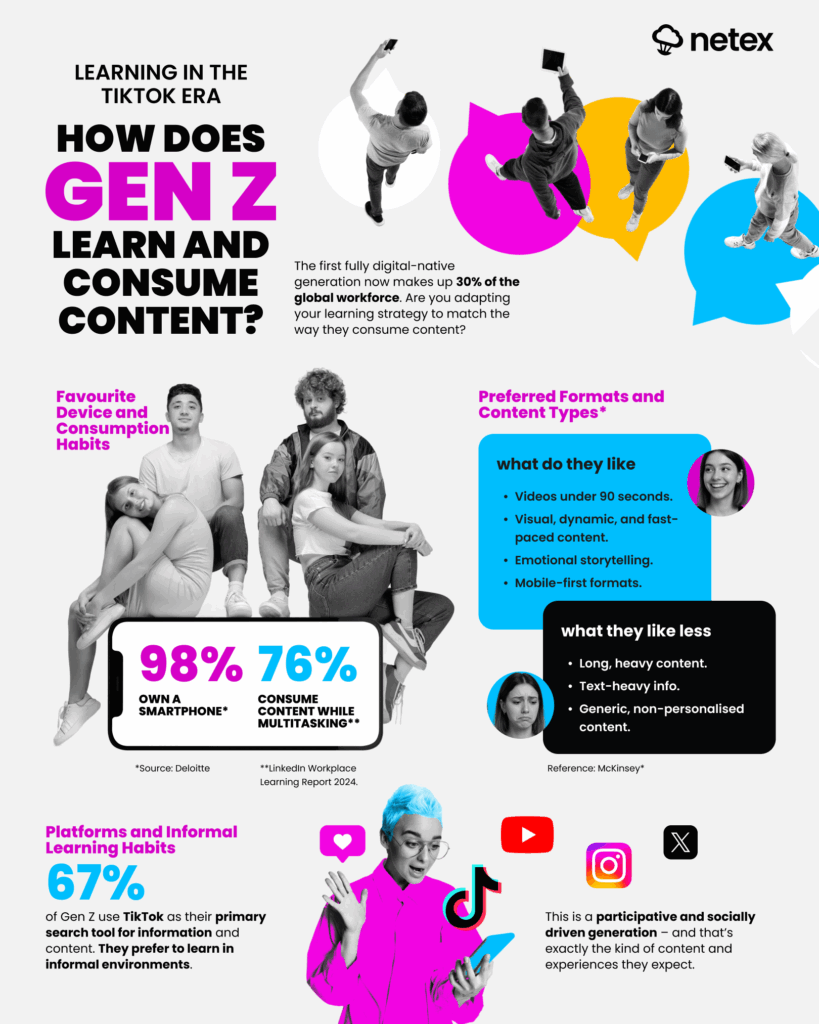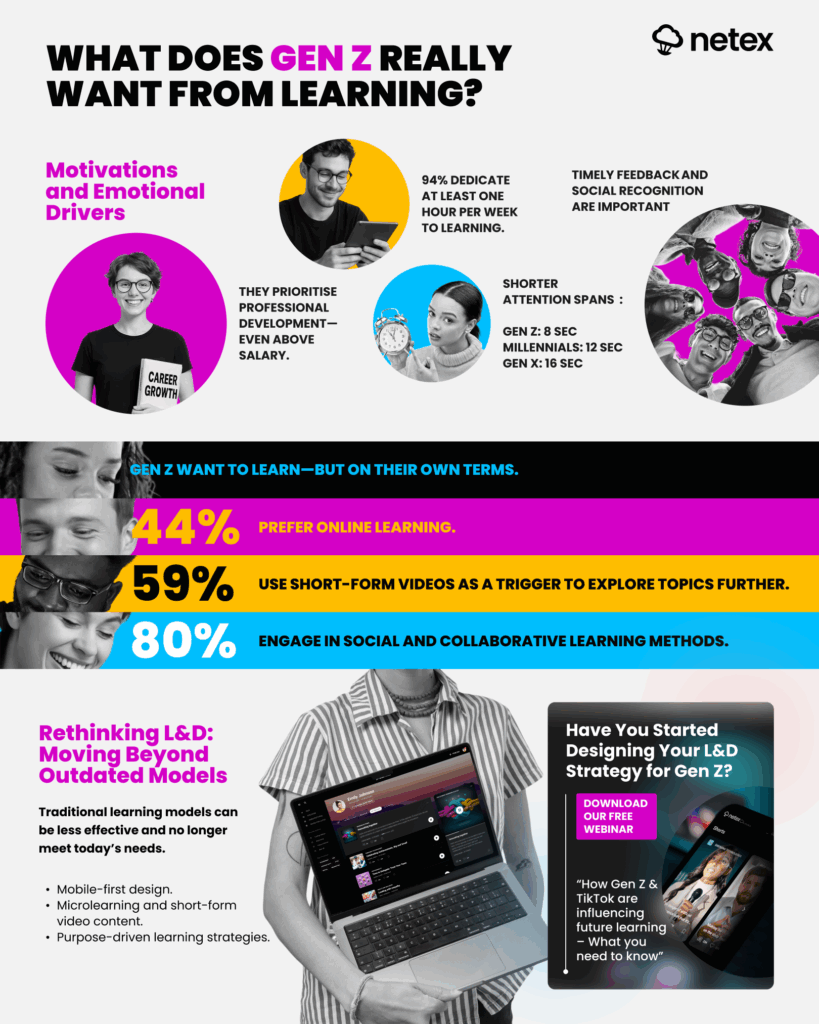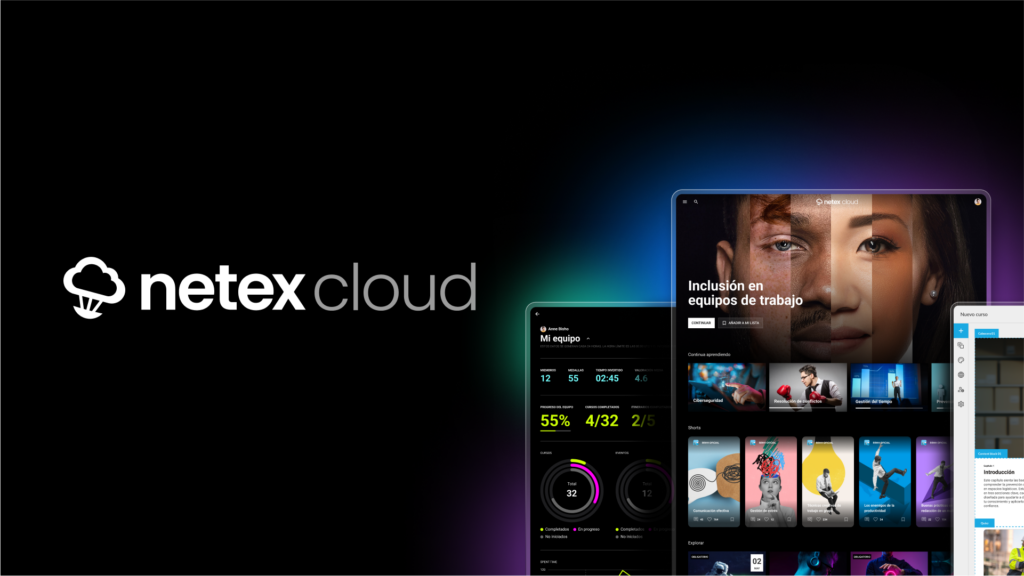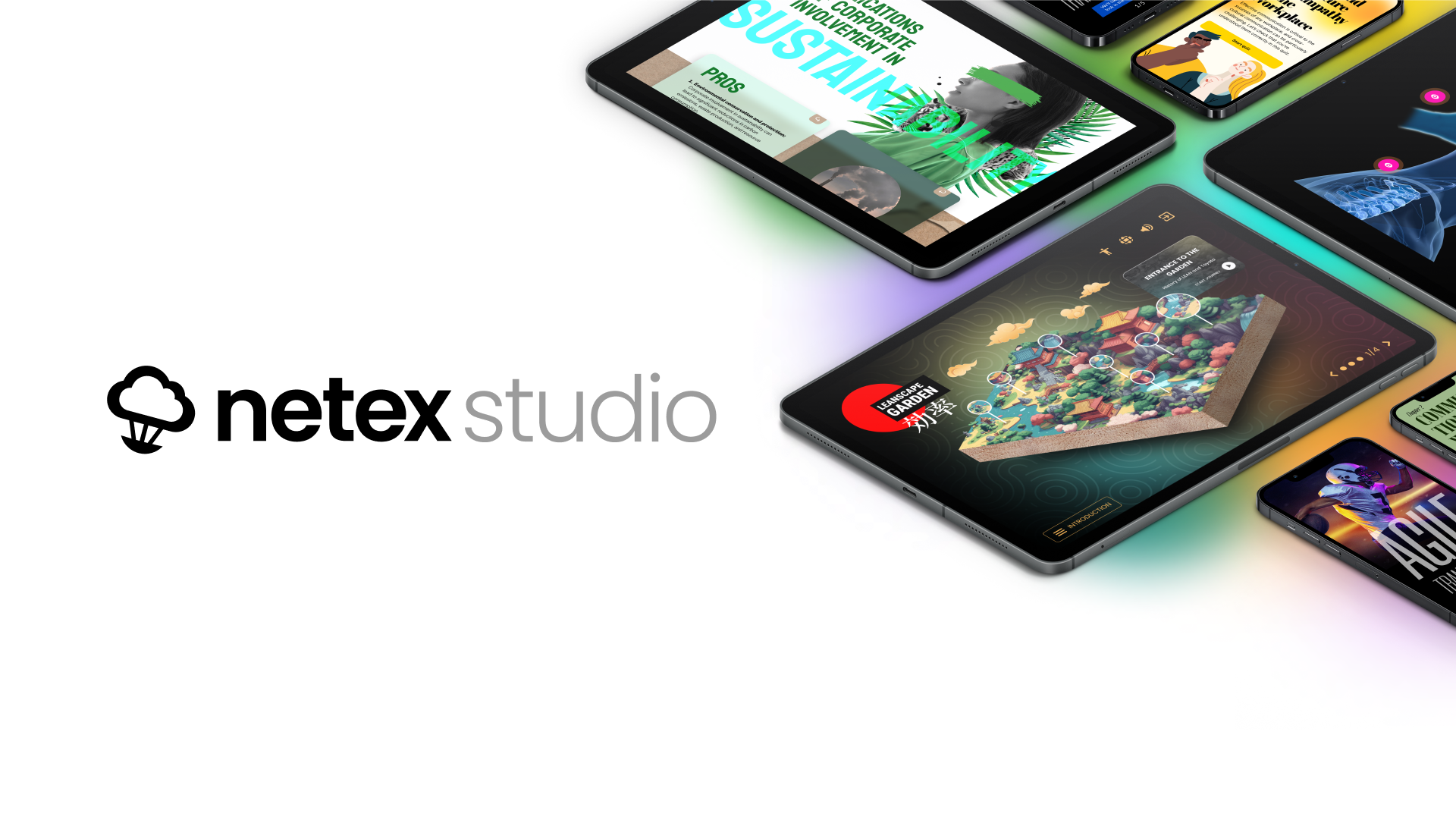Engaging employees with exciting, innovative learning techniques is a common problem that L&D leaders are looking to solve. With the rising numbers of Gen Z employees entering the workplace, the rise of TikTok-style video learning, offers a concise and dynamic alternative.
The days of traditional, long-form e-learning modules are slowly eroding, and more learning leaders are adapting to the dynamic learning experience that microlearning provides.
To help you elevate your L&D strategy and captivate learners of all ages, we’ve compiled 10 microlearning examples that deliver the highest impact on employee performance. We will show you not only the most effective formats, but also how to structure these examples of microlearning to move the needle.
What is Microlearning?
Microlearning effectively does what it says on the tin – it’s learning, just condensed into a digestible, smaller format. Often delivered through the medium of bite-sized learning or shortform videos, microlearning isn’t a new concept, rather its popularity has soared in the wake of emerging digital technologies and social media usage. For L&D professionals, this shift is essential for boosting engagement and knowledge retention, in a world where attention spans are increasingly shortening.
Microlearning Benefits for all Businesses
Adopting a microlearning strategy is more than just a passing trend; it’s a direct response to the modern learner’s needs, directly supporting your L&D objectives. It brings key advantages that make microlearning a powerful solution for employee training such as:
- Enhanced knowledge retention: Learners can easily recall topical concepts with singular modules of learning ensuring knowledge is retained effectively.
- Engage and captivate: Longform content can overwhelm and be less effective in keeping learners’ attention engaged, making even traditionally challenging topics like compliance or soft skills more palatable. This keeps employees focused and motivated to complete the training.
- Flexible, self-directed learning: Microlearning is easily accessible on mobile and provides employees with autonomous learning that fits around flexible working patterns and busy schedules.

Video Microlearning Examples
Whilst microlearning comes in various formats, shortform video is the undisputed king of microlearning currently. It’s captivating, scalable, and crucially it’s highly effective at reducing cognitive load. Here are first few microlearning examples below.
1.- TikTok-style explainer videos
Short-form explainer videos usually span between 30 to 90 seconds and are perfect for explaining single concepts, like a new policy update, a system feature, or a compliance reminder. Reflecting the rapid consumption style of TikTok, YouTube Shorts or Instagram Reels, the format entails fast cuts, kinetic on-screen text and background music. Learners can easily digest and understand the context in a format that is personable and relatable.
2.- Branching scenarios
Branching scenarios can be used to micro-simulate a workplace scenario, challenging the learner to choose the best response and immediately showing the consequences. This presents learners with opportunities to practice soft skills or make ethical decisions in risk-free environments.
3.- Animated Infographics
Infographics are a surefire way to present information in a clear, understandable format that resonates. Combining statistical data with visually-appealing can be the difference maker when presenting important information, such as procedures or complex product demos. Graphics, flowcharts, and icons invite better receptivity and enhance engagement, memory retention and better develop communication skills
4.- Annotated Product Demos
When a new piece of software rolls out or a product gets an update, a long manual is counterproductive. These videos are concise, focused recordings of a screen or process. Instead, opt for a short screen recording with voiceover and on-screen text to comply with accessibility best practice that is dedicated to a specific task or usage of a new training system or product.
This enables learners with support as they work, allowing access whilst operating an application or program that enhances efficiency and minimises workflow disruption.
Interactive Microlearning Formats
Microlearning should serve two core fundamentals – delivering engaging content that enables learners to retrieve information. Interactive formats provide employees with the tools needed to divulge further information which is conducive to impactful learning.
5.- Gamified Quizzes and Challenges
Healthy competition in the workplace should never be discouraged; it amplifies employee performance and promotes productivity. Gamification turns knowledge retrieval into a competitive, high-engagement activity. Formats of gamified quizzes can entail short snappy quizzes, drag-and-drop matching, or rapid-fire trivia questions. These can be aligned with incentives such as a badge achievement or leaderboard rankings.
6.- Digital Flashcards
A digital flashcard is a card that has a cue or hint on one side, with the flipside presenting an answer or solution to the information presented. The prominence of mobile learning has seen a rise in flashcards being utilised. Steeped in the theory of Ebbinghaus’s Forgetting Curve, digital flashcards are extremely useful for spaced repetition. This ensures knowledge is revisited at increasing intervals, before the learner is likely to forget it.

Performance Support Microlearning
The success and impact of learning can be attributed to ‘learning on-the-go’. Coordinating training with a hands-on task relating to a job is often the most effective way of delivering microlearning.
7.- Interactive Checklists and Workflow Guides
Checklists are something many of us use in our social and home lives to ensure any life admin is managed efficiently. In the workplace, processes where the order is crucial, such as safety procedures, complex machinery operation, or customer service intake, a dynamic checklist ensures consistency and prevents errors. Checklists for L&D are often presented in a digital, multi-step guide where the user must check off each stage. These often include embedded video clips or links to relevant resources, so learners can revisit any areas they are unclear on.
8.- Short-scroll pages
When policies or company mandates change, employees need the updated information quickly. Reading through a chunky PDF document or brochure isn’t going to engage or help learners locate critical information quickly and easily.
A scrolling page enables learners to break down content that is easy to follow, such as a complex policy or code of conduct with clear, concise, and visually separate illustrations.
9.- Action-based content
Action-based content reinforces the notion of immediacy during learning. Microlearning can be designed to ensure learners are actively deploying an action or theory upon the completion of a learning module. Action-based content is a true barometer of the effectiveness of a learning program, so you can adapt ore tweak your microlearning with your L&D partner should there be any changes needed. 9.
10. Audio and Podcasts
The popularity of audio books and podcasts is no secret, therefore integrating audio files and podcasts into your microlearning strategy should be a serious consideration. Create a series of audio files that your learners can access on demand and share between each other to learn during downtime or during social periods. Instil greater connections between employees, or even enable employees to create and record their own learning materials to share across the organisation to promote social learning.
Scale your microlearning with Netex
Hopefully, our examples of microlearning can help with any strategizing you’re thinking of when it comes to reshaping your L&D approach. Microlearning helps you create smarter, effective learning for all employees.
Netex Cloud and Netex Studio are our bespoke e-learning solutions, providing a diverse learning ecosystem that empowers your L&D team to create, manage, and scale microlearning formats across your organisation. This agile approach ensures your workforce remains engaged, knowledgeable, and ready to perform, no matter how quickly the business or market changes.
Share is our social learning platform that adopts the same functionality of social media, enabling social interactions such as likes and comments, turning collaborative learning into a strategic asset for your company.
Request a demo of Netex Cloud today and discover how our L&D experts can craft a microlearning strategy that can take your business to the next level, accelerating innovation and fostering a culture of learning that works for all.

